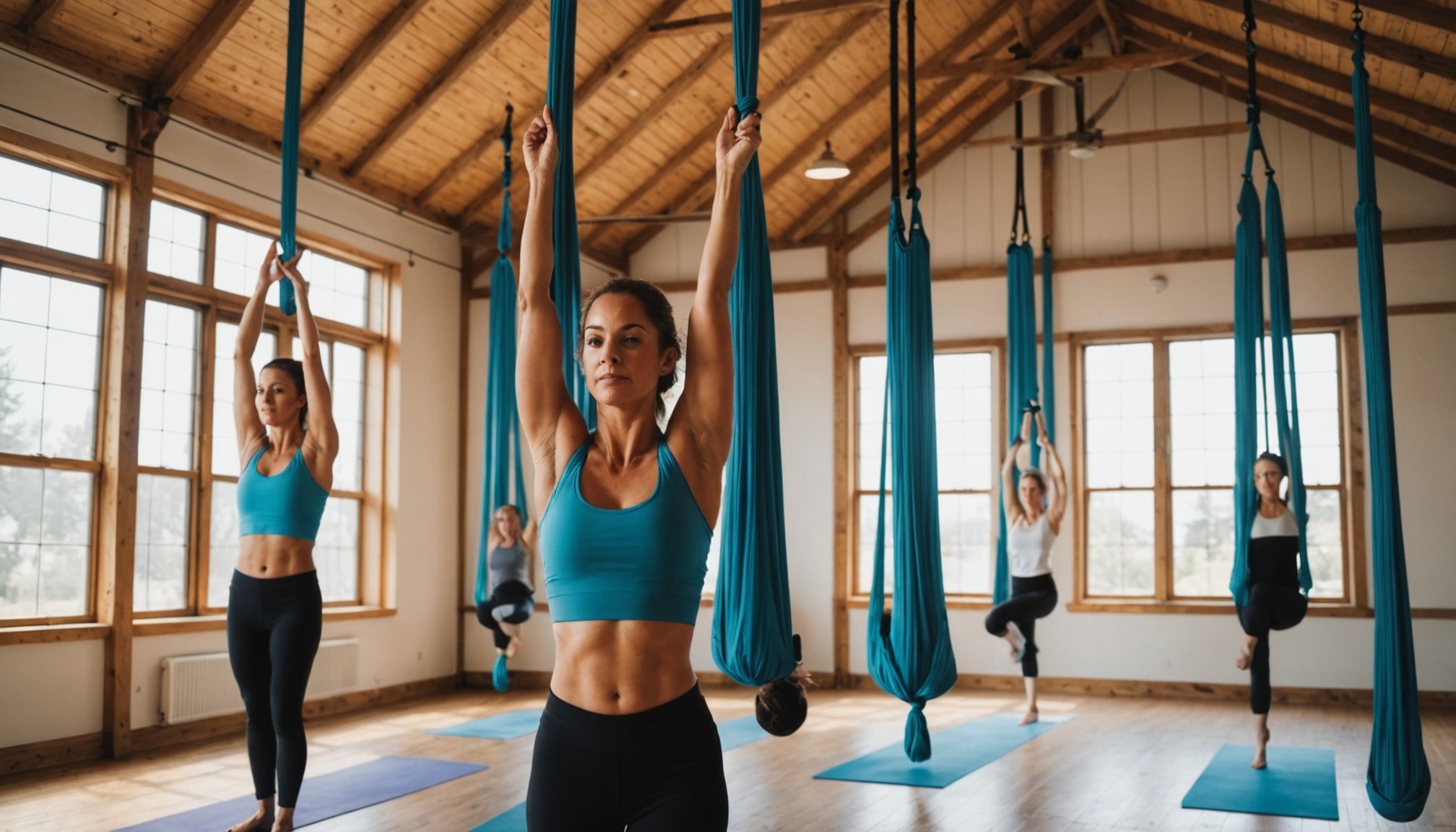The Benefits of Aerial Yoga for Flexibility and Wellness
Aerial yoga is renowned for its significant flexibility improvements, providing enthusiasts the opportunity to experience enhanced mobility and joint freedom. Utilizing suspended hammocks, practitioners can achieve deeper stretches than traditional yoga, effectively lengthening muscles and increasing the range of motion.
Beyond flexibility, aerial yoga is a holistic practice that greatly contributes to overall physical wellness. It promotes core strength, as maintaining poses in the air demands significant core engagement. Additionally, inversion poses, unique to aerial yoga, increase blood circulation and aid in detoxification, benefiting cardiovascular health.
Also read : Unlocking Social Skills: The Role of Pet-Assisted Therapy in Supporting Children with Autism
The mental health benefits of aerial yoga are equally profound, enhancing mental clarity and reducing stress. The practice encourages a mind-body connection, allowing for a meditative experience that calms the mind and improves focus. Many find it an enjoyable way to escape daily stresses and achieve a state of relaxation.
By integrating aerial yoga into regular fitness routines, practitioners can expect improvement not only in their physical flexibility but also in their wellness enhancement. Whether seeking to improve mental health, alleviate stress, or increase physical endurance, aerial yoga offers a multifaceted approach to wellness and vitality.
Also read : Maximizing Your Health: Top Strategies for Effective Fitness Tracker Use in Personal Wellness Monitoring
Comparing Aerial Yoga to Traditional Yoga
When it comes to yoga comparison, understanding the differences between aerial vs traditional yoga can help practitioners decide which style suits their needs best. Each type of yoga offers unique benefits and practices.
Differences in Practice
Traditional yoga involves performing poses on a mat, focusing on ground-based asanas and pranayama. In contrast, aerial yoga incorporates a suspended hammock, enabling practitioners to perform traditional poses off the ground and explore greater range of motion. Class structures can vary significantly; traditional yoga classes may be more meditative, whereas aerial yoga often introduces more dynamic movements.
Flexibility and Strength Development
Both types of yoga contribute to improved flexibility and strength. However, aerial yoga uniquely engages the core and upper body, enhancing muscular resilience. For individuals with injuries or physical limitations, aerial yoga offers low-impact exercises that alleviate pressure on joints while still providing significant physical benefits.
Adaptive Techniques in Aerial Yoga
Adaptive techniques in aerial yoga make it accessible for various skill levels. The hammock offers support, making it easier for beginners to attempt challenging poses. While traditional yoga utilizes props for modifications, aerial yoga naturally adapts to the practitioner’s body, offering a personalized experience. This can be particularly beneficial for those with limited mobility, allowing them to participate fully without strain.
Key Wellness Benefits of Aerial Yoga
Engaging in aerial yoga can yield several wellness benefits that enhance both physical and mental health. A significant advantage is the effective stress reduction it offers. By incorporating mindfulness and intentional breathing techniques during sessions, practitioners can experience a calming effect on the mind. This approach helps in releasing tension, thereby alleviating stress levels substantially.
Regular practice of aerial yoga contributes to noticeable improvements in mood and energy levels. The unique combination of gravity-defying poses and mindful breathing stimulates the release of endorphins, the body’s natural “feel-good” chemicals. As a result, participants often report feeling more energized and uplifted after sessions.
Moreover, the holistic nature of aerial yoga promotes comprehensive health. It combines aspects of physical activity, mental focus, and deep relaxation, creating a balanced and immersive healing experience. The practice encourages individuals to focus on their breath as they transition through poses, enhancing mental clarity and overall wellbeing.
In summary, aerial yoga presents a unique avenue for stress reduction, mood enhancement, and comprehensive wellness improvement. Whether for mental peace or physical vitality, aerial yoga is a compelling tool for achieving holistic health benefits.
Getting Started with Aerial Yoga
Embarking on your journey into beginner aerial yoga can be an exciting and rewarding experience. To make the most of your practice, it’s important to familiarise yourself with some aerial yoga tips and advice for starting aerial yoga on the right foot.
Essential Equipment and Setup
To ensure a smooth beginning, securing the right equipment is paramount. Key items include an aerial hammock, which is the central piece for beginner aerial yoga. This must be anchored securely to support your body weight safely. Additionally, a yoga mat can provide comfort and grip underneath. Equipping a space in your home or joining a studio should include ensuring enough vertical space and a sturdy mounting point. Adequate lighting and ventilation also contribute to an ideal practice environment.
What to Expect in Your First Class
A typical aerial yoga class kicks off with a warm-up followed by an introduction to basic poses. It’s natural for beginners to feel nervous due to height or the perceived complexity of aerial movements. However, instructors guide you patiently, focusing on simple, confidence-building poses. Beginners often discover an unexpected sense of freedom and support from the hammock, which eases common fears.
Recommendations for Finding Classes
When searching for aerial yoga classes, it’s crucial to seek out experienced instructors. Look for studios with qualified professionals who prioritise safe practices. Visiting studios beforehand can also provide insight into their professionalism and safety protocols, ensuring a positive aerial yoga experience.
Potential Risks and Considerations
Embarking on an aerial yoga journey can be exhilarating, but it’s essential to be mindful of potential risks. As with any physical activity, aerial yoga poses unique challenges that practitioners must be aware of. For instance, the use of hammocks and silk support can lead to the possibility of falls or strains if not appropriately handled. Therefore, understanding these aerial yoga risks is crucial.
Taking the time to incorporate safety considerations is vital before starting. Verify the installation and condition of the aerial equipment, ensuring it is securely anchored and has no visible wear or tear. Furthermore, opt for a class with qualified instructors who can supervise and guide in achieving proper form and alignment.
Health assessments are a necessary precaution before starting aerial yoga, especially for those with pre-existing conditions such as joint issues or cardiovascular concerns. Consulting with a healthcare provider can determine any limitations and tailor your practice to be safe and beneficial.
Ensuring a safe practice involves preparedness and knowledge of one’s limits. By addressing these health precautions and being aware of potential risks, enthusiasts can enjoy the benefits of aerial yoga with confidence and peace of mind.
Success Stories and Testimonials
Hearing from individuals themselves can be incredibly motivating, especially when it comes to aerial yoga success stories and personal testimonials. These narratives encapsulate not only physical transformations but also emotional growth and a strong sense of community.
Case Studies of Flexibility Improvements
Practitioners often highlight their journey towards increased flexibility. One story might involve an individual who initially struggled with rigidity, steadily improving through consistent practice of aerial yoga. Over time, these continued efforts led to notable physical transformations, enabling more advanced poses and enhancing overall body movement.
Mental Health Benefits Shared by Practitioners
Aerial yoga goes beyond physical rewards. Personal testimonials frequently emphasize emotional stability and mental solace gained from regular sessions. Participants often form meaningful connections in these classes, sharing experiences and building a supportive community. Many express feelings of rejuvenation and mental clarity as they engage with this unique practice.
Long-term Commitment to Aerial Yoga
Veterans in aerial yoga reflect on its profound cumulative benefits. They often provide insights into sustaining motivation, sharing personal tips like setting small goals and integrating aerial yoga into daily routines. Their stories serve as compelling evidence of the practice’s long-term advantages, encouraging others to explore and commit to aerial yoga.
Introduction to Aerial Yoga
Aerial yoga, a fusion of traditional yoga with elements of acrobatics and dance, elevates the practice quite literally by incorporating the use of a fabric hammock or sling. This modern form of yoga offers practitioners the ability to perform poses suspended in the air, providing an entirely new dimension to the exercise.
Definition and Origins
Originating in the early 2000s, aerial yoga combines traditional yoga poses, Pilates, and dance with the assistance of a hammock. This practice allows gravity to aid in achieving deeper stretches and alignment without undue strain on the joints. It’s popular for both its physical and mental benefits, appealing to those looking for an innovative fitness method.
Differences from Traditional Yoga
Unlike traditional yoga, aerial yoga challenges the body’s balance and core strength in unique ways. The hammock acts as a support system, enabling flexibility and a broader range of motion. This allows for inversions and backbends with reduced pressure on the spine, offering a novel approach to improving overall body awareness.
Essential Equipment and Setup
The foundational equipment for aerial yoga is a strong fabric hammock securely attached to the ceiling. Space considerations are essential, ensuring enough room for safe movement and exploration of poses. A professional setup is crucial to create a safe, supportive environment to practice this invigorating exercise.
Benefits for Flexibility
Aerial yoga offers a unique avenue to enhance flexibility through the incorporation of inverted poses. These poses allow practitioners to take advantage of gravity to deepen stretches, unlike traditional yoga. In inverted poses, the body relies on gravity to stretch muscles and increase the range of motion effectively. This gravitational pull helps elongate spine and muscle groups that are usually hard to stretch in regular floor-based yoga.
Aerial yoga techniques such as the “inverted butterfly” or “flying pigeon” encourage practitioners to explore these stretches without the limitations of floor contact. The hammock offers support, enabling individuals to hold and explore poses longer, thus enhancing muscle flexibility over time.
When comparing flexibility gains, aerial yoga often allows for quicker progress due to the dynamic stretching offered by gravity-assisted movements, which are typically less intense in conventional yoga practices.
Additionally, using aerial techniques may encourage deeper engagement in muscle groups, which aren’t as easily targeted on the mat, thus broadening the overall flexibility benefits of the practice. The hammock serves as both a support and a challenge, providing a comprehensive approach to improving flexibility in a fun and engaging way.
Impact on Overall Wellness
Aerial yoga offers substantial wellness benefits by fostering a profound mind-body connection. Practicing aerial yoga involves suspending the body in a hammock, which can significantly alleviate stress. This unique practice encourages mindfulness by requiring focused attention and deep breathing, both of which are known to lower anxiety levels. Moreover, being airborne can induce a sense of calm and relaxation, enhancing mental health immensely.
In terms of physical advantages, aerial yoga promotes superior body awareness and can lead to improved posture. By engaging various muscle groups, participants develop heightened muscle control and balance, crucial components of maintaining proper posture. This practice simultaneously strengthens core muscles and improves spinal alignment, thereby fortifying the body’s structural integrity.
Furthermore, aerial yoga aids in improving circulation and relieving muscle tension. The inverted positions commonly employed facilitate enhanced blood flow, delivering oxygen more efficiently throughout the body. This increased circulation, in turn, can reduce muscle tightness and elevate overall energy levels. Additionally, aerial poses can gently stretch and elongate the muscles, easing tension and promoting relaxation. By integrating aerial yoga into a weekly routine, individuals can enjoy a comprehensive range of wellness benefits that nourish both the body and mind.
Techniques and Instructional Guidance
Aerial Yoga Poses introduce a unique twist to traditional yoga by incorporating a hammock or silk to support various practice techniques. It provides a dynamic environment to enhance flexibility and strength.
Basic Poses
When beginning with Aerial Yoga, beginner poses like the “Inverted Butterfly” or “Aerial Plank” offer substantial benefits. These poses help develop a strong foundation by improving core stability and promoting a sense of balance within the silk. They are essential in building the confidence needed as you delve deeper into more complex moves.
Intermediate Poses
Transitioning to intermediate Aerial Yoga Poses requires mastering basic techniques to ensure a smooth progression. Focus on poses like the “Flying Pigeon” or “Star Inversion,” as they require deeper engagement of your core and higher levels of flexibility. Progressing to intermediate poses gradually helps maintain safety and prevent injury.
Safety Tips
Considering safety precautions during practice is crucial. Always ensure your hammock is securely anchored and check it for any signs of wear or tear. It’s helpful to practice under a certified instructor’s supervision, especially as you attempt more advanced moves. Understanding your body’s limits and pacing your practice is integral to enjoying the full benefits of Aerial Yoga.
Testimonials and Expert Opinions
Experiencing aerial yoga firsthand often leads to remarkable transformations, according to numerous practitioners. Many enthusiasts credit it as pivotal in their fitness journey. For instance, Jane Doe, a long-time practitioner, noted significant improvements in her flexibility and stress levels. Jane shares, “Aerial yoga allowed me to overcome barriers I couldn’t conquer with traditional yoga.”
Fitness professionals, familiar with a variety of practices, often support these claims. Dr. Alex Green, a certified yoga instructor, explains, “Aerial yoga adds a unique dimension to exercise by incorporating suspension. This challenges muscles in new ways and can aid in improving balance and posture.”
Expert insights reveal that the combination of traditional yoga postures with suspension harnesses gravity, enhancing the practice. This flexibility in movement often leads to better spinal alignment and reduced back pain for many participants. According to a recent study, over 70% of aerial yoga practitioners reported enhanced physical awareness.
Furthermore, real-life transformations serve as the cornerstone of aerial yoga’s appeal. Participants frequently report not just physical benefits but improvements in mental clarity and stress management. These personal experiences underpin the practice’s growing popularity, highlighting its holistic benefits.
Tips for Beginners
Learning beginner aerial yoga can be both exciting and intimidating. To start your journey, gather a few essential items: a quality yoga hammock, comfortable yoga attire, and a sturdy ceiling hook or stand for home use. Additionally, using a yoga mat can provide extra support during floor exercises.
For those new to aerial yoga, enrolling in recommended classes is vital. Look for instructors with experience in teaching beginners, as they understand the unique challenges beginners face. If in-person classes are not an option, explore online resources. Websites and video platforms offer a plethora of beginner classes, allowing you to practice in the comfort of your home.
Common mistakes can hinder progress and increase the risk of injury. Avoid rushing through poses; instead, focus on mastering foundational poses with proper form. Ensure your hammock is installed securely and start your practice with its height adjusted for safety.
Remember, progress comes with patience and consistent practice. Embrace the learning curve, celebrate small victories, and keep expanding your knowledge of aerial yoga. A steady, informed approach will enhance your skills and enjoyment of this invigorating exercise method.











